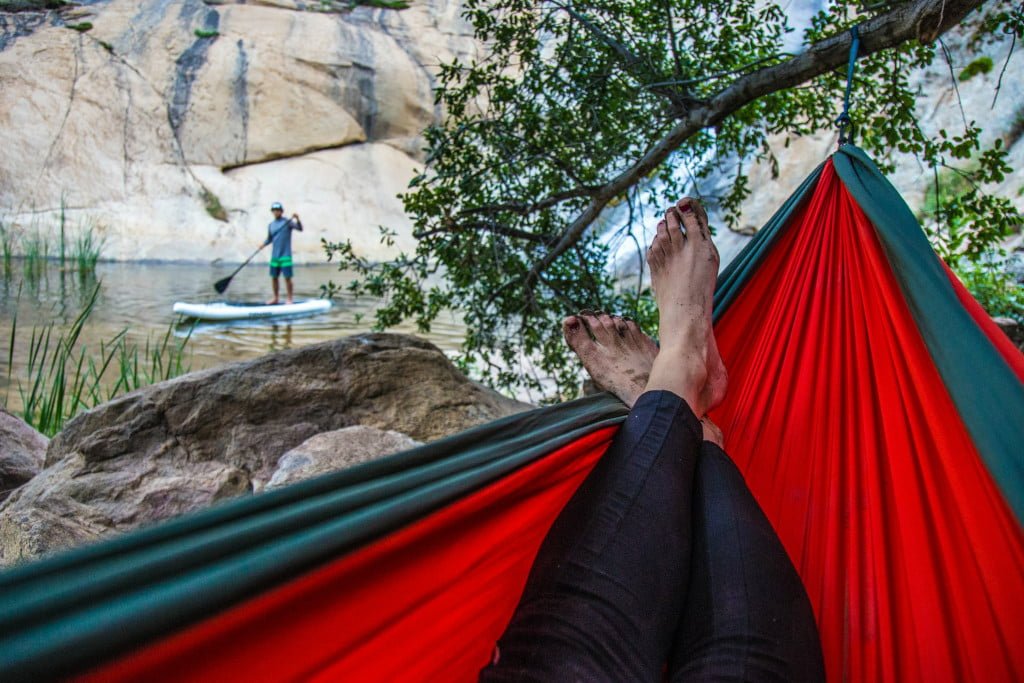
Sleeping in a Hammock
Updated on 2022-11-09
I’m a side sleeper and I began suffering from pressure point issues in my shoulders and hips sometime during my fourth decade of life. I read somewhere that Tempurpedic mattresses were supposed to be good for relieving pressure point issues. Therefore in 2004 or 2005, I decided to purchase a Tempurpedic mattress with a 3-inch built in topper.
I absolutely loved my Tempurpedic mattress and still do, but the pressure point issues eventually returned again, well before the end of the warrantied 20-year life of a Tempurpedic mattress. Additionally, I disliked the weight of my mattress and foundation; 76 pounds for the foundation and 148 pounds for the mattress for a total of 224 pounds. I still remember the team of 3 delivery guys who huffed, puffed, and grunted to get the mattress up to the second level of my home. There’s no way I could move the mattress on my own, other than to lift the edges of the mattress just enough to tuck a fitted sheet.
In 2014 I began researching ways to alleviate pressure point issues while sleeping and came across recommendations for sleeping in a hammock. A hammock would be much lighter than any mattress and foundation, and a hammock would take up much less room than a mattress and bed frame. Additionally, you can hang a hammock from the walls if you so desire.
I had concerns about whether or not sleeping in a hammock was good for your back though. I had experienced a disconcerting back pain episode in 2011, so I didn’t want to do something that might make my back worse. Although I didn’t come across any recommendations from medical authorities, I did come across a few comments on HammockForums.net by people who had switched to sleeping in a hammock because of back pain and they stated that sleeping in a hammock alleviated their back pain issues. In the spring of 2014, I made the decision to purchase a hammock stand and my first hammock.
I can’t remember whether I discovered Seaside Hammocks on the HammockForums.net site or if I found the vendor on my own, but I purchased my hammock stand and first hammock from Seaside Hammocks. The stand was a Vario hammock stand (no longer available about a year after my purchase) and a Mayan Tommy Hamaca Grande Cool Rainbow hammock.
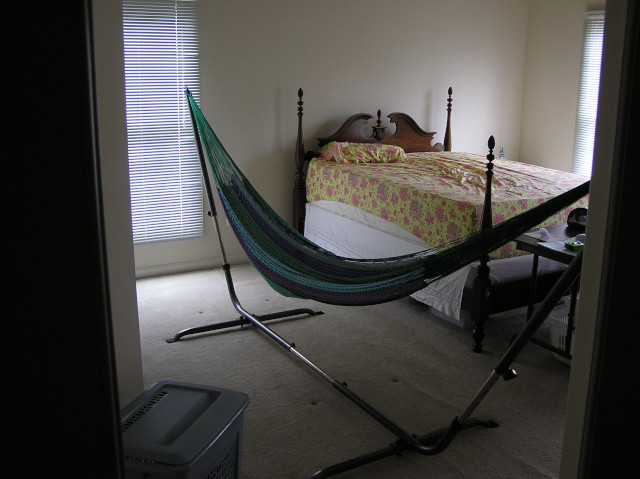
I had never slept in a hammock before, so it wasn’t the most comfortable experience initially. I tried sleeping on my back because that was the recommended position from the research I had done prior to purchasing my hammock stand and hammock. After night 10 of sleeping in my hammock, I awoke in the morning laying in the middle of the hammock on my back, curled in the position of a banana.
Based on the research I had done, you are supposed to sleep at an angle in the hammock to flatten it out and to give you better back support. I always tried sleeping at an angle, but that night I must have moved to the middle in my sleep. When I got out of the hammock, the lumbar area of my back was really stiff and sore, so much so that the pain and stiffness caused me to walk like an old man. It took me a few weeks to get over the pain and stiffness.
I kind of dismissed the incident as my back just getting adjusted to the new sleep platform and I continued to sleep in my hammock. I did more research about sleep positions on the HammockForums.net site and I read comments by some who said they were able to sleep on their side comfortably in their hammock. Therefore, I began sleeping on my side when sleeping on my back became uncomfortable.
I eventually became accustomed to sleeping in my hammock and I grew to love the experience. I felt like I was in a cocoon when I slept in my hammock. I experienced no pressure point issues whatsoever, I slept more soundly than I ever had previously, and I dreamed much more. One negative experience of sleeping in my hammock was kidney discomfort when I slept on my back, but I had read that was normal.
The Mayan Tommy Hamaca hammock was very airy to sleep in, well suited to sleeping in warm temps. However, the airiness was not suited to cooler temps. We had an unusually cold night one night in July 2014 where the temps went down into the 40s. A low in the 40s is very abnormal in my area for the summer months. I was uncomfortably cold sleeping in the hammock that night and I knew I would probably need a hammock made from a different material for the cooler weather months.
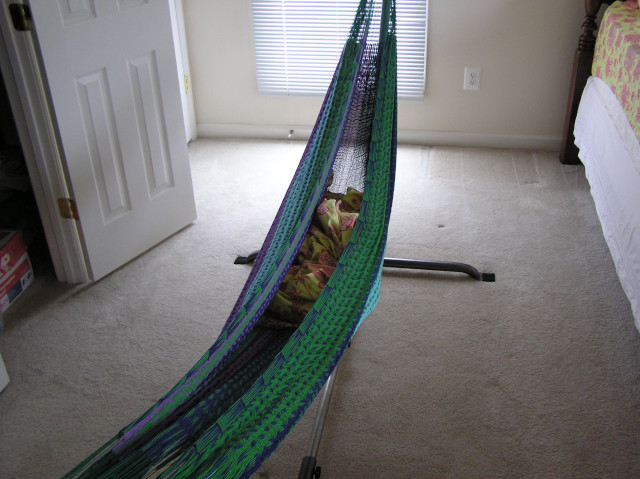
One thing I did not consider when making my initial purchase was the fact that eventually you need to wash the hammock. After washing the hammock, you need to hang it to dry out, so I would need another hammock to use to enable me to wash and dry the other hammock. I purchased another Mayan Tommy Hamaca Grande hammock from Seaside Hammocks in August 2014, but I chose the Dot Stripe Tropicals color scheme.
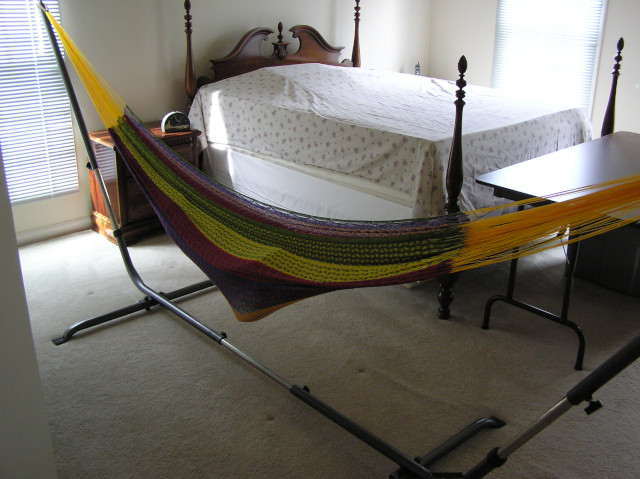
I also went ahead and purchased two cooler weather hammocks, also from Seaside Hammocks, choosing the Icarai Rainbow King Size hammock and the Organic Merlot Family hammock.
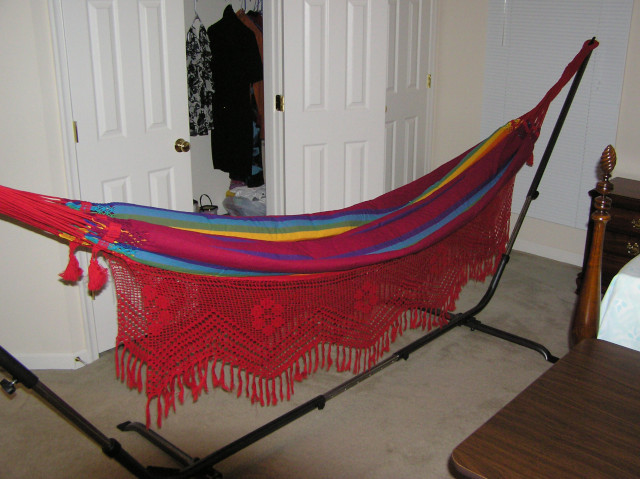 | 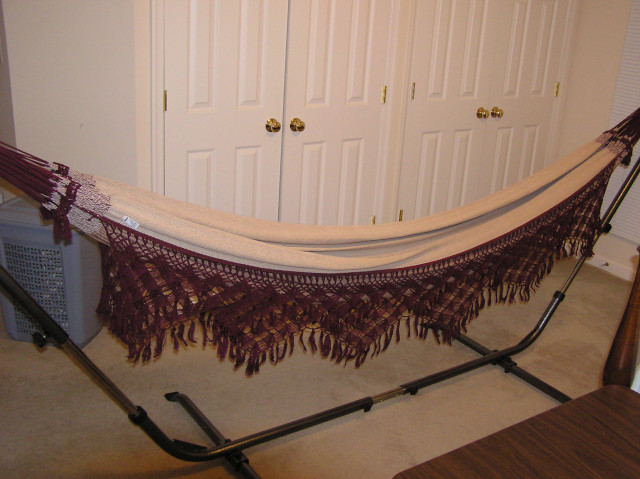 |
The Icarai Rainbow King Size hammock was beautiful, but unfortunately it was much too large for my hammock stand. The hammock sagged to the floor when I laid in it, even with the hammock stand extended to it’s longest length. Therefore, I purchased an Elite Organic Naturale Brazilian Family hammock about a month later. Unfortunately, I didn’t take a picture of that hammock for some reason and the current image of the hammock on the Seaside Hammocks site is too small, but it looked similar to the Double Deluxe Brazilian hammock below.
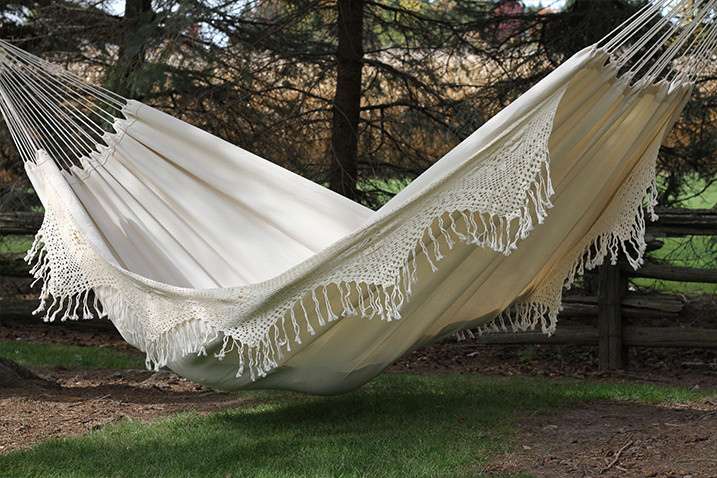
I did some research on HammockForums.net about sleeping in cold weather and one of the recommended items was a sleeping bag. Therefore, I purchased two sleeping bags rated at 40-50 degrees fahrenheit from Campmor. I thought the sleeping bags would be warm enough, but my assumption turned out to be incorrect. Sleeping in my Organic Merlot hammock was a bit uncomfortable at night due to my not being warm enough.
I prefer sleeping in my underwear only, so perhaps sleeping bag temperature ratings assume wearing full clothing. Another item mentioned on HammockForums.net for cold weather hammock sleeping was a sleeping bag placed underneath the hammock. I didn’t want to do that and I thought maybe a blanket might work. I decided to purchase two queen-size fleece blankets from Lands’ End.
The queen-size fleece blankets were large enough for me to fold them in half, with one half under my sleeping bag and the other half covering the top of my sleeping bag. The fleece blankets worked out great.
Washing the hammocks was a bit of a chore due to their size. The Brazilian hammocks were quite heavy when wet. Before washing the hammocks, I would tie the suspension cords with nylon string to prevent the cords from becoming tangled. I washed the hammocks in a soaker tub using Ecover laundry detergent for delicate fabrics (no longer available).
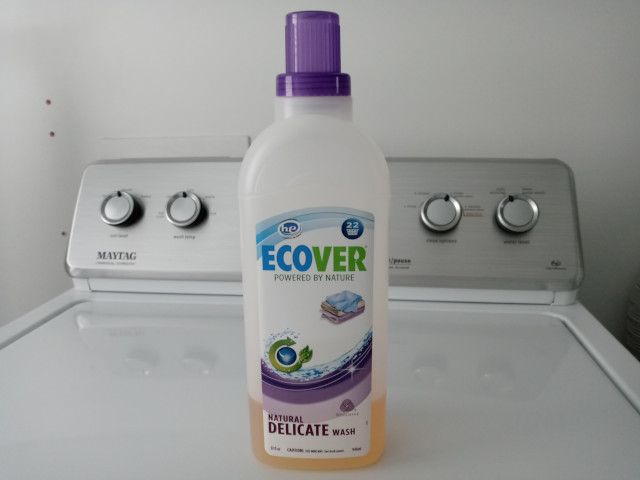
I would fill the soaker tub with enough water and laundry detergent to wash the hammock, leave the hammock soak for a few minutes, handwash the hammock, drain the water, refill the tub, rinse the hammock, and then drain the water. I gently pushed on the hammock to manually remove as much water as possible. I then used a Tubtrug, purchased from Gardener’s Supply Company, to transport the wet hammock to the washing machine and I then would run the hammock through a drain and spin cycle to remove the excess water.
Once the hammock had gone through the drain and spin cycle, I would hang it in the basement using carabiners and slings connected to two eye screws that I had placed in two pieces of 2-in x 4-in lumber nailed between two floor joists. I used a Grip’N Grab Reach Tool to spread the center of the hammock to insure that the hammock dried thoroughly.
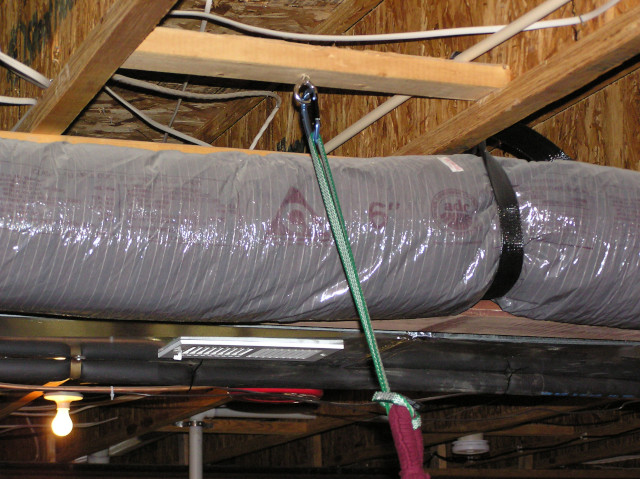 | 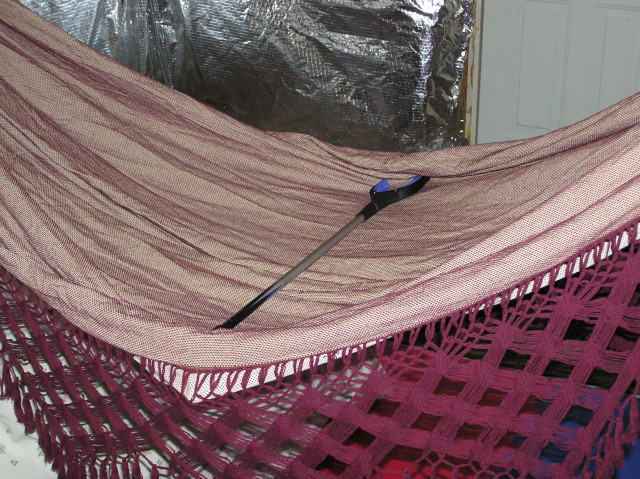 |
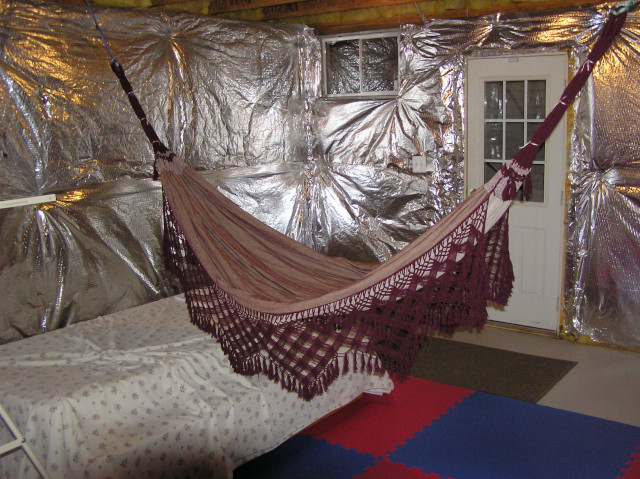 |
I hadn’t experienced any more back issues from sleeping in the hammock since the first incident. However upon awakening one morning in early April 2015, I knew I was in trouble as soon as I got out of the hammock. My back was even more stiff and sore than the first incident. The back pain and stiffness once again affected how I walked. I had also just been diagnosed with a herniated L-4 (fourth lumbar) disc that was pressing on the L-4 nerve root, causing foot drop in my left foot.
The April 2015 incident ended my time of sleeping in the hammock and I began sleeping on my Tempurpedic mattress again. I asked the orthopaedic spine specialist to whom I had been referred if sleeping in a hammock could have caused my herniated disc, but he said he didn’t think it had anything to do with it. However, a couple of years later, I conferred with Dr. Douglas Gillard who said that sleeping in a hammock could very well cause a herniated disc due to spine flexion.
I attempted to sell my hammock stand and hammocks on Craigslist, but I received lowball offers and that was without even seeing the items in person. I ended up advertising the hammock stand for free on Craigslist and a woman in the area wanted it. I didn’t want to go through the hassle of advertising and giving away each hammock separately using Craigslist, so I just donated them to a local Salvation Army Thrift Store. I spent over $1,200 total for the hammock stand and hammocks; money down the drain.
If you have degenerative disc disease, or think you might, I would not recommend sleeping in a hammock. Although sleeping in a hammock may not have been the sole cause of my herniated disc, it very well may have aggravated an existing condition. Question or comment? Leave it in the Comment box at the bottom of the page.
Post header image courtesy of Tower Paddle Boats, at Unsplash.
2021-005




